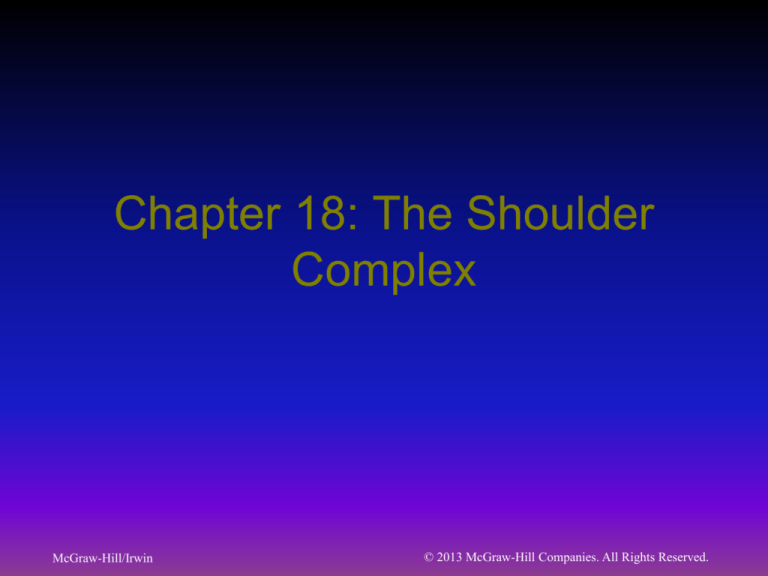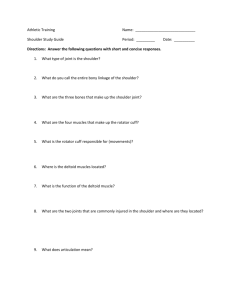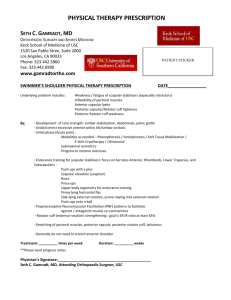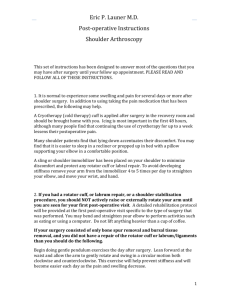
Chapter 18: The Shoulder
Complex
McGraw-Hill/Irwin
© 2013 McGraw-Hill Companies. All Rights Reserved.
• The shoulder is an extremely complicated
region of the body
• Joint which has a high degree of mobility
but not without compromising stability
• Involved in a variety of overhead activities
relative to sport making it susceptible to a
number of repetitive and overuse type
injuries
• Movement and stabilization of the
shoulder requires integrated function of
the rotator cuff muscles, joint capsule and
scapula stabilizing muscles
18-2
Anatomy
18-3
18-4
18-5
18-6
Prevention of Shoulder
Injuries
• Proper physical conditioning is key
• Develop body and specific regions
relative to sport
• Strengthen through a full ROM
– Focus on rotator cuff muscles in all planes
of motion
– Be sure to incorporate scapula stabilizing
muscles
• Enhances base of function for glenohumeral
joint
18-7
• Warm-up should be used before
explosive arm movements are
attempted
• Contact and collision sport athletes
should receive proper instruction on
falling
• Protective equipment
• Mechanics versus overuse injuries
18-8
Throwing Mechanics
•Instruction in proper throwing mechanics
is critical for injury prevention
18-9
• Windup Phase
– First movement until ball leaves gloved hand
– Lead leg strides forward while both shoulders
abduct, externally rotate and horizontally abduct
• Cocking Phase
– Hands separate (achieve max. external rotation)
while lead foot comes in contact w/ ground
• Acceleration
– Max external rotation until ball release (humerus
adducts, horizontally adducts and internally
rotates)
– Scapula elevates and abducts and rotates
upward
18-10
• Deceleration Phase
– Ball release until max shoulder internal
rotation
– Eccentric contraction of ext. rotators to
decelerate humerus while rhomboids
decelerate scapula
• Follow-Through Phase
– End of motion when athlete is in a
balanced position
18-11
Assessment of the Shoulder
Complex
• History
– What is the cause of pain?
– Mechanism of injury?
– Previous history?
– Location, duration and intensity of pain?
– Creptitus, numbness, distortion in
temperature
– Weakness or fatigue?
– What provides relief?
– Training changes?
18-12
• Observation
– Elevation or depression of
shoulder tips
– Position and shape of clavicle
– Acromion process
– Biceps and deltoid symmetry
– Postural assessment
(kyphosis, lordosis,
shoulders)
– Position of head and arms
– Scapular elevation and
symmetry
– Scapular protraction or
winging
– Muscle symmetry
– Scapulohumeral rhythm
18-13
• Palpation
– Bony structure palpation should occur
bilaterally and simultaneously if possible
– Palpate soft tissue structures for point
tenderness, swelling, spasms, lumps,
guarding or trigger points
– Be sure to palpate anteriorly and
posteriorly
18-14
• Special Tests
– Active and Passive Range of Motion
• Flexion, extension
• Abduction and adduction
• Internal and external rotation
– Muscle Testing
• Muscles of the shoulder and those that serve
as scapula stabilizers
18-15
Apprehension test
• Apprehension
test used for
anterior
glenohumeral
instability
– This motion
should not be
forced
18-16
• Test for Shoulder Impingement
– Neer’s test and Hawkins-Kennedy test for
impingement used to assess impingement of soft
tissue structures
– Positive test is indicated by pain and grimace
18-17
Test for Supraspinatus
Weakness
• Empty Can Test
– 90 degrees of
shoulder flexion,
internal rotation and
30 degrees of
horizontal adduction
– Downward pressure
is applied
– Weakness and pain
are assessed
bilaterally
18-18
• Test for
Sternoclavicular
Stability
– Pressure applied
superiorly, inferiorly &
anteriorly to assess for
pain and stability
• Test for
Acromioclavicular
Stability
• Pressure applied to
distal end of clavicle
in 4 directions
18-19
Recognition and Management
of Specific Injuries
• Clavicular Fractures
– Cause of Injury
• Fall on outstretched arm, fall on tip of shoulder or
direct impact
• Occur primarily in middle third (greenstick fracture
often occurs in young athletes)
– Signs of Injury
• Presents w/ supporting of arm, head tilted towards
injured side w/ chin turned away
• Clavicle may appear lower
• Palpation reveals pain, swelling, deformity and
point tenderness
18-20
• Care
– Closed reduction sling and swathe,
immobilize w/ figure 8
brace for 6-8 weeks
– Removal of brace
should be followed w/
joint mobes, isometrics
and use of a sling for 34 weeks
– Occasionally requires
operative management
18-21
• Fractures of the Humerus
– Cause of Injury
• Shaft fractures occur as a result of a direct blow, or
fall on outstretched arm
• Proximal fractures occur due to direct blow,
dislocation, fall on outstretched arm
– Signs of Injury
• Pain, swelling, point tenderness, decreased ROM
• X-ray is positive for fracture
– Care
• Immediate application of splint, treat for shock and
refer
• Athlete will be out of competition for 2-6 months
depending on location and severity of injury
18-22
• Sternoclavicular Sprain
– Cause of Injury
• Indirect force, blunt trauma
– Signs of Injury
• Grade 1 - pain and slight disability
• Grade 2 - pain, subluxation w/ deformity, swelling
and point tenderness and decreased ROM
• Grade 3 - gross deformity (dislocation), pain,
swelling, decreased ROM
– Possibly life-threatening if dislocates posteriorly
– Care
• PRICE, immobilization
• Immobilize for 3-5 weeks followed by graded
reconditioning
18-23
• Acromioclavicular Sprain
– Cause of Injury
• Result of direct blow (from any direction), upward
force from humerus, fall on outstretched arm
– Signs of Injury
• Grade 1 - point tenderness and pain w/ movement;
no disruption of AC joint
• Grade 2 - tear or rupture of AC ligament, partial
displacement of lateral end of clavicle; pain, point
tenderness and decreased ROM
(abduction/adduction)
• Grade 3 - Rupture of AC and CC ligaments with
dislocation of clavicle; gross deformity, pain, loss
of function and instability
18-24
– Care
• Ice, stabilization, referral to physician
• Grades 1-3 (non-operative) will require 3-4
days (grade 1) and 2 weeks of immobilization (
grade 3) respectively
• Aggressive rehab is required w/ all grades
– Joint mobilizations, flexibility exercises, &
strengthening should occur immediately
– Progress as athlete is able to tolerate w/out pain and
swelling
– Padding and protection may be required until painfree ROM returns
18-25
18-26
• Glenohumeral
Dislocations
– Cause of Injury
• Head of humerus is
forced out of the joint
• Anterior dislocation is
the result of an anterior
force on the shoulder,
forced abduction,
extension and external
rotation
• Occasionally the
dislocation will occur
inferiorly
18-27
• Signs of Injury
– Flattened deltoid, prominent humeral
head in axilla; arm carried in slight
abduction and external rotation; moderate
pain and disability
• Care
– RICE, immobilization and reduction by a
physician
– Begin muscle re-conditioning ASAP
– Use of sling should continue for at least 1
week
– Progress to resistance exercises as pain
allows
18-28
• Shoulder Impingement Syndrome
– Cause of Injury
• Mechanical compression of supraspinatus
tendon, subacromial bursa and long head of
biceps tendon due to decreased space under
coracoacromial arch
• Seen in over head repetitive activities
– Signs of Injury
• Diffuse pain, pain on palpation of subacromial
space
• Decreased strength of external rotators
compared to internal rotators; tightness in
posterior and inferior capsule
• Positive impingement and empty can tests
18-29
• Care
– Restore normal
biomechanics
– Strengthening of
rotator cuff and
scapula stabilizing
muscles
– Stretching of
posterior and
inferior joint capsule
– Modify activity
(control frequency
and intensity)
18-30
• Rotator cuff strains
• Involves supraspinatus or rupture of other
rotator cuff tendons
• Primary mechanism - acute trauma (high
velocity rotation)
• Occurs near insertion on greater tuberosity
• Full thickness tears
– Athletes w/ a long history of impingement or
instability (generally does not occur in athlete under
age 40)
– Signs of Injury
• Present with pain with muscle contraction
• Tenderness on palpation and loss of strength
due to pain
• Loss of function, swelling
• With complete tear impingement and empty
can test are positive
18-31
– Care
• RICE for modulation of pain
• Progressive strengthening of rotator cuff
• Reduce frequency and level of activity initially
with a gradual and progressive increase in
intensity
18-32
• Shoulder Bursitis
– Etiology
• Chronic inflammatory condition due to trauma or
overuse
• May develop from direct impact or fall on tip of
shoulder
– Signs of Injury
• Pain w/ motion and tenderness during palpation in
subacromial space; positive impingement tests
– Management
• Cold packs and NSAID’s to reduce inflammation
• Remove mechanisms precipitating condition
• Maintain full ROM to reduce chances of
contractures and adhesions from forming
18-33
• Bicipital Tenosynovitis
– Cause of Injury
• Repetitive overhead athlete - ballistic activity
that involves repeated stretching of biceps
tendon causing irritation to the tendon and
sheath
– Signs of Injury
• Tenderness over bicipital groove, swelling,
crepitus due to inflammation
• Pain when performing overhead activities
– Care
• Rest and ice to treat inflammation
• NSAID’s
• Gradual program of strengthening and
stretching
18-34
• Contusion of Upper Arm
– Cause of Injury
• Direct blow
• Repeated trauma could result in development
of myositis ossificans
– Signs of Injury
• Pain and tenderness; increased warmth
• Discoloration
• Limited ROM
– Management
• RICE for at least 24 hours
• Protect contused area to prevent repeated
episodes that could cause myositis ossificans
• Maintain ROM
18-35









